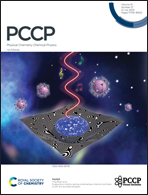Imaging rotational energy transfer: comparative stereodynamics in CO + N2 and CO + CO inelastic scattering
Abstract
State-to-state rotational energy transfer in collisions of ground ro-vibrational state 13CO molecules with N2 molecules has been studied using the crossed molecular beam method under kinematically equivalent conditions used for 13CO + CO rotationally inelastic scattering described in a previously published report (Sun et al., Science, 2020, 369, 307–309). The collisionally excited 13CO molecule products are detected by the same (1 + 1′ + 1′′) VUV (Vacuum Ultra-Violet) resonance enhanced multiphoton ionization scheme coupled with velocity map ion imaging. We present differential cross sections and scattering angle resolved rotational angular momentum alignment moments extracted from experimentally measured 13CO + N2 scattering images and compare them with theoretical predictions from quasi-classical trajectories (QCT) on a newly calculated 13CO–N2 potential energy surface (PES). Good agreement between experiment and theory is found, which confirms the accuracy of the 13CO–N2 potential energy surface for the 1460 cm−1 collision energy studied by experiment. Experimental results for 13CO + N2 are compared with those for 13CO + CO collisions. The angle-resolved product rotational angular momentum alignment moments for the two scattering systems are very similar, which indicates that the collision induced alignment dynamics observed for both systems are dominated by a hard-shell nature. However, compared to the 13CO + CO measurements, the primary rainbow maximum in the DCSs for 13CO + N2 is peaked consistently at more backward scattering angles and the secondary maximum becomes much less obvious, implying that the 13CO–N2 PES is less anisotropic. In addition, a forward scattering component with high rotational excitation seen for 13CO + CO does not appear for 13CO–N2 in the experiment and is not predicted by QCT theory. Some of these differences in collision dynamics behaviour can be predicted by a comparison between the properties of the PESs for the two systems. More specific behaviour is also predicted from analysis of the dependence on the relative collision geometry of 13CO + N2 trajectories compared to 13CO + CO trajectories, which shows the special ‘do-si-do’ pathway invoked for 13CO + CO is not effective for 13CO + N2 collisions.

- This article is part of the themed collection: 2023 PCCP HOT Articles


 Please wait while we load your content...
Please wait while we load your content...